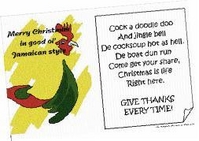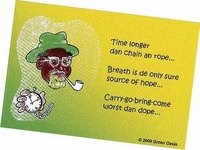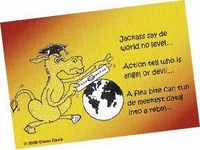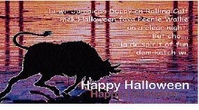KEEPERS OF THE HERITAGE: E-cards with a 'yaad' flavour
Published: Sunday | November 15, 2009


Before the Internet, buying and sending greeting cards was a popular pastime across the world. Sending cards is still popular, but more and more people are not buying printed mass-produced copies, choosing instead to send them electronically. This is less costly and it takes only seconds for delivery of the cards. This is a quantum leap from the primitive origin of greeting cards.
The practice of sending greeting cards, it is said, started with the ancient Chinese as New Year's gifts, and the ancient Egyptians who wrote messages on papyrus scrolls. By the early 1400s handmade personalised cards were being distributed in Europe, but it wasn't until 1843 that the first Christmas card was made, and that was in England.
With the advancement of printing technology in the 1850s, cards were now being printed, and in the 1860s, companies like Marcus Ward & Co and Goodall and Bennett began the mass production of greeting cards. Since then, the greeting-card industry has grown significantly to be one of the biggest and most far-reaching in the world.
The evolution of the greeting card continued with the advent of the World Wide Web. In 1995, E-Cards.com started to host online greetings featuring nature and wildlife photos. Valentine's Day 1996 saw the first real transition to sentimental online greetings, when Valentine's cards were produced by Infobahn.com and Sony Entertainment, among others.
But in all of this, the messages and images of greeting cards reflected mostly the customs, sensibilities and art of the United States and Europe. The cards that were being sent by people from the Caribbean to their connections abroad were similar to the ones being sent by such connections to the Caribbean.
West Indian culture


Over the years, attempts have been made to produce cards that depict the cultures of West Indian peoples, but invariably, the stronger international companies and the penchant for West Indians to embrace all things foreign have stymied the growth of indigenous greeting card industries.
About 1994, when returning resident Desmond Green, a research psychologist, and his wife, Dawn, went to a pharmacy to get Christmas cards, it occurred to them that none of the cards had messages and images that were truly Jamaican. Immediately, they came up with the idea of producing their own Jamaican cultural Christmas cards, he being a writer and she, a graphic artist.
In a discussion with Green, recently, he said "the need for a cultural line of greeting cards that reflected and respected our Jamaican imagery and messages" was great. What he saw in the pharmacy was not what he, the man from Christiana, Manchester, wanted to send abroad.
The brainstorming began as an exciting Desmond whipped up his first 'lyrics', which included "Cock a doodle do, and jingle bell, the cock soup hot like hell, di boat dun run, come get your share, Christmas is life right here." His wife then created artworks to match the lyrics, and Green Oasis greeting cards were born.
With the samples done, they approached private individuals to test the waters. The cards were an immediate hit, and by word of mouth the news of their existence got around. The Ministry of Education became interested, and even the then governor general, Sir Howard Cooke, was impressed and bought some. The cards were also placed at post offices, which turned out to be quite successful. Yet, Green Oasis was to learn one of the most important lesson in business - marketing is key, no matter how novel and relevant the product is.
Being a small family business, the marketing was not as vigorous and aggressive as it should have been and Green Oasis was competing with the established international brands. The push for the cards was not coming from retailers, so sales dropped and the Greens withdrew them, with the hope of redefining their marketing thrust, bearing in mind the potential the cards have for success.
electronic greeting cards
"This culturally rich collection creates the ideal context for dynamic social interaction between Jamaicans at home and abroad while shaping the creation and adoption of new understandings for diversity tolerance," Green Oasis says.
The Greens returned to the United States in 2000, but the idea of producing cultural greeting cards was still very much alive, and they thought of ways to revive the sales of the product. Last year, Green Oasis restarted the production of the cards, and this year, the Greens decided to go electronic, eventually producing the first Jamaican electronic greeting cards, a few months ago.
Jamlink.com and Green Oasis Publications have collaborated to offer a collection of free Caribbean e-cards, on www.jamlink.com. "While the Green Oasis line offers traditional birthday, sympathy, get-well and love cards, its collection of Yard-Style and Rasta Vibes are especially spiced with great Jamaican wisdom and philosophy, and yes, they are from the same publishers who in the '90s brought you such card lyrics as 'Cornwall, Middlesex and Surrey, every ram goat married to curry'," Green Oasis says.
"The Green Oasis collection promotes Jamaican and Caribbean culture, connecting and reconnecting Caribbean peoples across the globe. The Jamlink/Green Oasis partnership is dedicated to the social role of cultural sharing, to help people stay in touch, and to raise cultural awareness."
Thus, Green Oasis Publications is using e-cards not only to keep people in touch and to tighten the ties that bind, but it is also helping to keep our culture and heritage flying high. And that's why Desmond and Dawn Vaz-Green are this week's keepers of the heritage.
paul.williams@gleanerjm.com

















